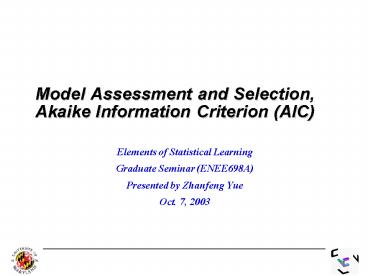Model Assessment and Selection, Akaike Information Criterion AIC
1 / 16
Title:
Model Assessment and Selection, Akaike Information Criterion AIC
Description:
Model Assessment and Selection, Akaike Information Criterion (AIC) ... Model selection: Estimating the performance of different models to choose the best one. ... –
Number of Views:794
Avg rating:3.0/5.0
Title: Model Assessment and Selection, Akaike Information Criterion AIC
1
Model Assessment and Selection,Akaike
Information Criterion (AIC)
- Elements of Statistical Learning
- Graduate Seminar (ENEE698A)
- Presented by Zhanfeng Yue
- Oct. 7, 2003
2
Talk overview
- Introduction to model selection and assessment
- Problem formulation
- In-sample error and optimism
- Akaike Information Criterion (AIC)
- Kullback-Leibler information number
- Reasons for AIC
- Model selection using AIC
- Effective number of parameters
3
Model Selection and Assessment
- Two goals
- Model selection Estimating the performance of
different models to choose the best one. - Model assessment Having chosen a final model
estimating its prediction error. - If we are in a data-rich situation, the best
approach is to randomly divide the data set into
three parts - Training set
- Validation set
- Testing set
4
Problem Formulation
- We have a signal, , where
- is the output,
- is the input, and
- is the noise
- We have a training set .
- We would like to find a predictor for given
, , so that . - The training error is .
- Typically can be reduced by increasing the
complexity of the model.
5
Optimism of Training Error
- We focus on the in-sample error,
- , where is the loss function.
- We define optimism, op as the expected difference
between the in-sample error and the training
error.
6
Errin for Linear Models
- We can show for different loss functions that
- Therefore,
- We can show for linear fit with d inputs
- The optimism increases linearly with the number d
of inputs, but decreases as the training sample
size N increases.
7
A Fitting Problem
- Data is generated according to an unknown
parametric density - . Let denote a k-dimensional
parametric family of densities. Our goal is to
search among a class of families for the
fitted model - , that best approximates .
- To determine which of the fitted models
- best resembles , we need a measure that
gauges the disparity between the true model
and an approximation model
.
8
Kullback-Leibler Information Number
- Assume that our data follow the true distribution
g(y), and f(y) is our statistical model to
approximate g(y). - A ruler to measure the similarity between the
statistical model and the true distribution is
the Kullback-Leibler information number - It can be shown that -I(g,f) is the entropy. To
minimize the Kullback-Leibler information number
is to maximize the entropy.
9
Log-likelihood
- Only the second term is important in evaluating
the statistical model f(y), which can be written
as (when ). - Therefore, can replace the Kullback-Leibler
information number as a criterion of evaluating
models. - Log-likelihood
10
Reasons for AIC
- The maximum log-likelihood method cannot be used
to compare different models without some
corrections. - Using as an estimate of
produces a bias. The reason for such bias to
occur is that the same data are used to estimate
parameters and to calculate the log-likelihood. - An unbiased estimate of yields the famous
Akaike Information Criterion (AIC). - The expectation value of the bias is
11
AIC
- When a log-likelihood loss function is used, the
following relation holds as . - where is a family of densities for Y,
is the maximum-likelihood estimate of , and
loglik is the maximized log-likelihood
12
Model Selection Using AIC
- Simply choose the model giving smallest AIC over
the set of models considered. - Given a set of models indexed by a tuning
parameter , define - Our final chosen model is , where is
the tuning parameter that minimizes .
13
Note
- If we have a total of p inputs, and we choose the
best-fitting linear model with inputs,
the optimism will exceed . Put another
way, by choosing the best-fitting model with d
inputs, the effective number of parameters fit is
more than d. - The formula
- holds exactly for linear models with additive
errors and squared error loss, and approximately
for linear models and log-likelihoods. In
particular, the formula does not hold in general
for 0-1 loss.
14
The Effective Number of Parameters
- Stack the outcomes into a vector y, and
similarly for the prediction . Then a linear
fitting method is one for which we can write ,
where S is an NxN matrix depending on the input
vectors , but not on . - The efficient number of parameters is defined as
- If S is an orthogonal projection matrix onto a
basis spanned by M features, then trace(S)M.
15
Models Like Neural Network
- For models like neural networks, in which we
minimize an error function with weight decay
penalty (regularization) , the
effective number of parameters has the form - ,
- where is the eigenvalues of the Hessian
matrix .
16
Conclusions
- The model selection and assessment is briefly
reviewed. - The Akaike Information Criterion (AIC) for model
selection is derived. - The effective number of parameters is introduced.































